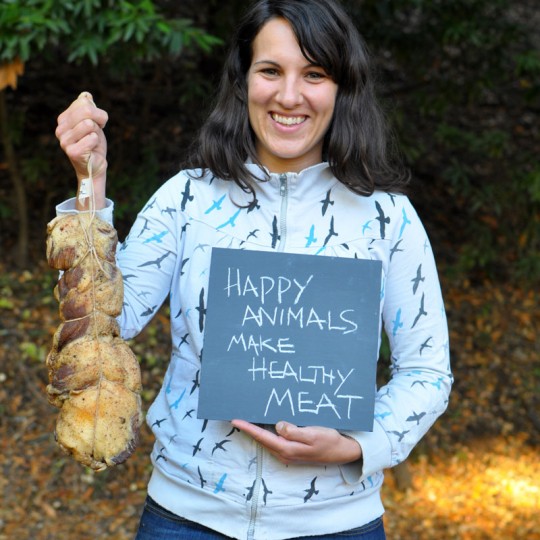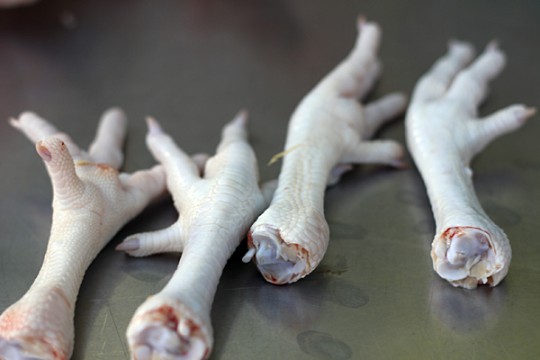
Last month I had the amazing opportunity to attend Eat Retreat, a weekend gathering of 40 food innovators from around the country who came together to share food and ideas. I was flattered to be invited, and as I read through the list of attendees I was in awe of how much they had all accomplished in the food world. But as the group formed and our individual interests and offerings evolved into an agenda for the event, my experience from the season I was spending on a livestock farm (in addition to some farm-cured guanciale) became something I could bring to the table. We as a group had the opportunity to butcher the chickens we would eat for Saturday night dinner, and I was asked by the coordinators if I would be willing to lead a hands-on chicken slaughter workshop.
On Friday afternoon everyone arrived a few at a time, introduced ourselves and immediately fell into easy conversation. In the course of hours we slurped oysters, watched a lamb breakdown, feasted on a collaborative meal, sipped beautiful wines, and gathered around a campfire to introduce ourselves. There was lots of talk and enthusiasm that night about the morning slaughter. Some people told me they were looking forward to it, despite the fact that they anticipated it would be outside their comfort zone. Others asked, with just a bit too much enthusiasm, “Can I kill a chicken tomorrow?!” I woke up on Saturday in my bunk at Hidden Villa, a beautiful educational farm in the Los Altos hills of California, with a thought I’ve had many times: “It’s chicken butchering day”. But my head swam with thoughts of how I would share the experience with others, and I found myself hoping that I could offer guidance and encouragement while still appropriately conveying the gravity of our task.

When the time came I started with what I do best. I talked. I spoke of the principles I’ve come to own over the past eight months in regard to raising animals for food; as a livestock farmer I hope to provide a healthy life and a respectful death. I talked about determination and the importance of following through – once you take a knife to an animal’s throat, hesitation will only cause suffering. I warned them of potential hazards, like blood spray and involuntary bowel movements. Slaughtering chickens is a messy job. And then I set to work, praying that my hands would do what I’ve trained them to do, despite the presence of an audience and the pressure to perform. In that moment I wanted only to be the swift killer I strive to be.
I demonstrated butchering 3 birds, walking the captive group through the steps that follow slaughter, including scalding, plucking, eviscerating and preparing the edible organs. Having described each step in detail as I moved through the motions, I intended to let everyone go to work and offer guidance as needed – after all, this is a group of people who have intimate relationships with food and are all competent, if not professional, cooks. But taking a knife to the throat of a living thing is not an easy task, and it was necessary for me to physically coach and emotionally support each individual through the act of slaughter. One by one I led them first in the moves I have internalized, “take the the feet in your right hand and now take the head in your left. Place the tip of your knife there…” and then in the final act, “OK, now take a deep breath and whenever you’re ready, just do it.”

On a recent episode of Good Food, a radio show that I love, I heard host Evan Kleiman describe taking the life of an animal for food as the ultimate culinary act. It was an intense, challenging and ultimately valuable moment that I had the privilege to share with my fellow Eat Retreaters. Every single person depended on me being there by their side to complete the task and afterwards I was repeatedly thanked for the experience of the slaughter. It turned out to be a monumental moment in the retreat for everyone who participated. But I could only offer thanks in return for trusting in me. Teaching others gave me the opportunity to process and share the both the thoughts and skills I honed over the time I lived and worked at North Mountain Pastures.
For dinner that night, we ate chicken. Not a single person seemed to find this unappetizing. Instead they were inspired. The cooks assigned to that night’s dinner altered the menu to pay proper respects to the animals who gave their lives to our meal – those chickens spent the day soaking in a “Cleopatra bath” (which I’m told involved buttermilk and herbs). They were skillfully grilled and served alongside a bounty of side dishes, washed down with local wines and microbrews. Even the feet were fried crunchy crisp and I for one nibbled and sucked those chicken toes until they had not a drop of deliciousness left to give. Throughout the weekend we continued to share stories, laughter, knowledge and of course food in good company. I left with 39 new friends (well, 38 actually, as the lovely Kimberley Hasselbrink was the one who planted the Eat Retreat seed) and much excitement for all the things I hope to accomplish in the food world.

When I returned to Pennsylvania and the farm for what were my last few weeks, the task at hand was the final poultry butchering push of the season. In a single day I slaughtered 300 chickens and 25 ducks, and later that week I helped prepare 180 turkeys for Thanksgiving tables. Despite the soreness it provoked in my shoulders, it felt good to fall into the rhythm of this process one last time. I thought of the leap my fellow Eat Retreaters took with me, and I remembered the day many months ago when I too held a knife to a chicken’s neck for the first time hoping I would get it right. Bringing healthy animals to grateful tables is a charge I find fulfilling, and slaughter is a necessary part of this process. Ultimately it’s like dancing; you internalize the movements and they will always be in your muscle memory. When the time comes, you just have to have to remember to breathe and go for it.
The chicken slaughter workshop was documented both in words and video by Mr. Will Turnage. You can read more about the weekend and the workshop in other blog posts by Mike Lee, David Scheidt, and Rachel Adams.



ally says:
wow, this is so interesting! i love how you remind me to be aware, respectful, and grateful of what i’m eating.
Daughter Fish says:
Your advice to your fellow retreaters reminds me of Julia Child’s advice about cooking in general, that you must have the courage of your convictions. This is a great story! It’s very cool that everyone got to take part in bringing the birds to the table, and that these animals were enjoyed so thoroughly! I’m excited to see what you do in the food world, too!
Courtney says:
What an amazing experience! Great post, thanks for sharing!
Heather says:
Thanks for the encouraging words ladies! It was super rewarding for me to be able share the experience with others. If you’re curious and up for it, you should check out the youtube video:
http://www.youtube.com/watch?v=w2gXn6BzP2k
Mama Red (Lucky Eat Retreat Attendee 2012) says:
This was an amazing workshop to be a part of.
I was taken back by the bravery and vulnerability that fellow retreaters showed and how you helped each one of them work through this process.
The chicken was delicious, the chicken feet that Andrew prepared were to die for…I know I said the chicken feet.
Well done :)0
Heather says:
Yes! It was super inspiring how many people who hadn’t planned to be “hands-on” stepped up to participate after watching others. And those chicken feet… probably my favorite thing I ate all weekend. I’ve been craving them ever since.
Alt-Mama says:
As someone who was a vegan for many years and has ultimately landed somewhere in the omnivorous locavore milieu, I found this post intriguing on a variety of levels; I’ve always thought that if people are going to eat meat, we need to be okay with where that meat comes from. I used to be more hardcore about it — “if you couldn’t slaughter it, don’t eat it” — but now I just feel very grateful for the people who can (skills and willingness-wise) raise and slaughter happy, healthy meat for my grateful table. My role as a consumer, as I see it, is to choose meat that’s been raised in a humane and happy way. I got a little dizzy looking at the photos in the post (I don’t know if I could bring myself to kill a chicken, even though I’ll be happy to eat one), but I’m impressed — rather than turned off — by the experience you’ve been through, and are passing on to others. It really IS the ultimate culinary act! Can’t wait to see what you cook up next.
Mike says:
Great video! I’ve always enjoyed meat but have only recently been able to come to terms with where my food comes from. Please accept my sincere appreciation for the education this post provided. I would think pigs and goats would be more challenging though – do you have similar tutorials there?
Heather says:
Thanks Mike! Pigs and goats are indeed more challenging – I’ve been heavily focused on butchery training over the past few months and hope to share more on the subject soon.